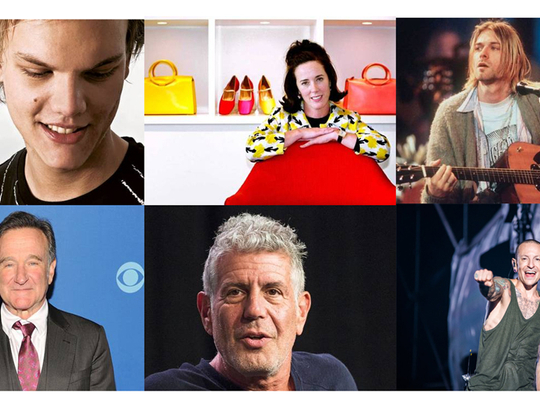
June saw two high-profile suicides happen within three days of each other – fashion designer and entrepreneur Kate Spade, and chef and TV host Anthony Bourdain. While it has once again brought the focus of the public eye on mental health issues including depression, this is no new ball game. Just earlier this year, Avicii – world-renowned DJ and music producer – took his own life, shocking fans worldwide.
Kate Spade, designer and entrepreneur was found dead in her apartment on June 5
Understanding celebrity suicides
Dona Cherian, Guides Writer
Suicide is not a new issue, especially not in celebrity circles. These tragic deaths are also not limited by lines of work, ranging from boxers, designers, politicians and writers to actors, musicians and entrepreneurs.
The fact that these people – the crème-de-la-crème of our world, in terms of skills, wealth and fame – decided to take their own life, is what needs to be assessed. The question most people ask is this, “Why would they want to take their own life, when they had ‘everything’?” But did they have everything, or does it even matter what they had or didn’t have in material possessions and fame?
Why?
‘Why’ is a question that is always asked by those left behind or hurt by these suicides – the answer or answers would never make sense to someone who loves life.
Anthony Bourdain, chef and TV host, was found unresponsive in his hotel room on June 8
There are a myriad of situations, conditions and causes for a person wanting to take his or her own life, according to a research report released in 2005. The reason for a suicide need not always be because of a mental health issue such as depression or a bipolar disorder. While there are several cases of depressed, schizophrenic and bipolar patients becoming suicidal, it is not universal to these conditions.
A person with no clinical mental issues could be suicidal, just as a depressed or mentally stressed person may not be.
But the one factor this report claims as being universal to all suicide victims and suicidal patients is that there is significant to extreme emotional pain suffered – regardless of the source of such pain. The researchers also reiterate that suicide is a flawed and extreme ‘problem-solving’ tactic for these patients – a quick fix.
Kurt Cobain, singer of the band Nirvana, shot himself in 1994
Many of these patients suppress emotional pain or stress, instead of facing it or accepting it. Their avoidance strategy and lack of control makes them then go to extreme measures to hide, manage or suppress this emotional stress. According to the study, suicide is one of many ‘coping’ methods for such individuals, which include drug abuse, alcohol abuse, self-harm, addictions and eating disorders.
In short, the study says that, suicide is a reasonable ‘last resort’ in the minds of suicidal patients – who think they have tried and tested every other solution.
Also read: Suicide prevention resources and helplines in the UAE
The study observes that suicide is, for a suicidal person, an extreme answer to ‘intolerable, interminable and inescapable emotional pain’. This is even when there might be other solutions to the problem, but according to the patients everything else has not worked.
Celebrity suicides
According to Maslow’s hierarchy of needs, a human’s motivation needs are divided into five tiers. Abraham Maslow, an American psychologist came up with these levels of needs that a human has in life, and the satisfaction of which give him or her motivation to act in a certain way.
The base tier is survival with physiological or physical needs, followed by safety needs, affection needs, esteem needs and, finally self-actualisation needs.
Also read: Celebrity deaths that shook the world
Among celebrities, most people, going by this hierarchy are at esteem needs or even self-actualisation needs. That would mean happiness or motivation to live, but then the question arises as to why suicides are high among these established and accomplished individuals. Aren't they the ones who should be happiest?
Happiness vs. unhappiness
Happiness is a subjective term for many but science has attempted at making sense of this feeling. Happiness can be fleeting or forever, but what defines happiness?
The Harvard Study of Adult Development followed the lives of 724 men placed in two groups for a period of 75 years to find the effect of psychosocial factors on life. Their wives were included later in the study. Most of the original participants have died now and now their kids – over 2000 individuals – are part of a second generation study in to what makes a good, healthy and happy life.
Jiah Khan, a Bollywood actress, hanged herself in her Mumbai home in 2013
“The surprising finding is that our relationships and how happy we are in our relationships has a powerful influence on our health,” said Robert Waldinger, director of the study, in 2017 as published in the Harvard Gazette.
A psychiatrist at Massachusetts General Hospital and a professor of psychiatry at Harvard Medical School, Waldinger spoke at a Ted series and said, ““When we gathered together everything we knew about them about at age 50, it wasn’t their middle-age cholesterol levels that predicted how they were going to grow old. It was how satisfied they were in their relationships. The people who were the most satisfied in their relationships at age 50 were the healthiest at age 80.”
This would mean, based on the study, that the most important factor in a healthy happy mind and life would be relationships – the third tier of Maslow’s hierarchy. Marital relationships and other forms of companionship could even make physical pain mean less, the study says. This would mean even emotional pain, the kind that leads to suicides, could be managed with strong key relationships.
Loneliness par all levels
“Loneliness kills. It’s as powerful as smoking or alcoholism”, Waldinger said in the same Ted talk he gave in 2017. Looking at some of the most prominent suicides this year and before that, loneliness has always been a culprit as friends, colleagues and family have pointed out. This phenomenon doesn’t differ based on who the person is or how much wealth or fame they have amassed in their life.
Bill Zeller, best known as the creator of MyTunes, committed suicide in 2011
Kate Spade’s former publicist, Rob Shuter, gave an interview Extra TV (a celebrity TV series) and said, “Kate was really isolated and lonely. Toward the end of her life, she had a housekeeper, she had her assistant, and her child, and I think that was pretty much it. Kate didn’t have many friends.” Anthony Bourdain’s ex-girlfriend Paula Froelich tweeted about his death saying, “You can be rich as hell, totally successful but still lonely…” Bourdain was also a recovering drug addict.
According to a small-sample study done in 2009, “It is lonely at the top for persons who find themselves alone and isolated on an island of recognition, where there is a loneliness that happens because you are separate.”
Mental health issues
All of this is not to say that mental health problems don’t have an effect on suicidal thoughts. Depression is the most common reason for suicides, at almost 90 per cent. Schizophrenia, extreme anxiety, posttraumatic stress disorder (PTSD), substance abuse and personality disorders (bipolar disorders) are other factors that could lead to suicides.
Also read: Five most common mental health issues in the world
Robin Williams, award-winning Hollywood actor, took his own life in 2014
Celebrities, at the height of their fame, are prone to anxiety and depression due to isolation and the feeling of having to meet unreasonable expectations of the public.
Suicide: The despair of loneliness - Comment
Anupa Kurian-Murshed, Social Media Editor
Every 40 seconds, one person commits suicide, worldwide. Sounds horrifying, but it is an actual statistic from the World Health Organisation (WHO).
And less than one per cent of that makes headlines. Obviously, not enough is being said about this global phenomenon, which is the 17th leading cause of death.
The WHO says that “close to 800 000 people die due to suicide every year.... Many more attempt suicide. Suicide occurs throughout the lifespan and is the second leading cause of death among 15- to 29-year-olds globally.”
When celebrities like Kate Spade, Robin Williams and Anthony Bourdain take their own life, the world is stunned. They had everything - money, fame and wealth, why then? Why such an extreme step generally perceived to be something that people without any hope resort to?
The answer perhaps lies in the 1950’s psychoanalyst Frieda Fromm-Reichmann’s path-breaking work on the idea of emotional isolation, or simply put - loneliness. And this is not some romantic notion of solitude, rather a screaming, desperate need to connect, to be understood, even when surrounded by people.
Everybody has those moments in life, but Nature has designed us to respond and react to it. We run back to the village, or in today’s world we call our loved ones and wait for the heartrate to drop, as the warmth of nurture calms the frayed nerves.
Nature has designed mothers for this express purpose. Another reason why scientists have found a greater proponence for suicide or suicidal thoughts in those from broken homes, abusive parents and poor familial relationships.
No man is an island, we love to say. But, that is the evolutionary truth.
Today Fromm-Reichmann’s work has been expanded upon to become the field of social neuroscience, especially by late professor John Cacioppo, who studied loneliness for over two decades. He was the director of the University of Chicago’s Centre for Cognitive and Social Neuroscience and wrote the seminal book, Loneliness: Human Nature and the Need for Social Connection.
In an interview with the UK-based newspaper The Guardian, he said: “There is a big difference between objective isolation and perceived isolation, and very quickly we learned that perceived isolation was loneliness.
“The classic case is the billionaire who sees that everyone wants to be their friend, but in the billionaire’s eyes none of those are effective, because they are seen as being motivated by material gain.
“Actually I think loneliness is a bit like pain, hunger and thirst, and we don’t have opposites for them either, except, pain-free, or not hungry, not thirsty. Loneliness is the same way.”
And in today’s world it is assuming epidemic proportions, especially, as the way we live changes.
People are moving all the time - for work, education, family reasons or simply to seek. While this makes a global village of the world, what it also does for many is increase their sense of isolation. Not to confuse it with being physically alone, rather it is a sense of reduced reciprocal connectivity. There are new cultures, social structures and community environments to absorb.
Cacioppo told The Guardian: “...social support. This suggests that lonely people will be ‘cured’ just with the support of people around them. That is not the answer either because getting out of loneliness takes reciprocal connections not one-directional ones. If it were just about support, people would not feel lonely in hospital because they are surrounded by it. But we know that people in hospital often feel very lonely.”
Also read: Suicide prevention resources and helplines in the UAE
People seem like they are adapting but what runs beneath the surface might be anxiety and an inability to achieve kinship at the social pace necessary. This pushes them to turn inwards, as a means to self-preserve - a tortoise pulling into its shell. They appear sociable, but the loneliness grows like a disease, invading, infesting every thought.
Science has proven that genetics does play a strong role in pre-determining the probability of chronic loneliness that destroys mind and body, along with the chemical impact of lifestyle choices such as alcoholism and drug abuse. Then there are also those of a lower intellect, easily influenced and manipulated.
But, there are those who do not fall into any of these categories. Sometimes the strongest and the most intelligent find it the hardest to go on.
Many presume, suicide is an impulsive action, but in a species designed to ‘fight or flight’ at any sense of imminent danger or pain, the decision to willingly inflict fatal self-harm belies that assumption. It would most probably have come from a place of profound loneliness and the darkest depths of despair.
Perhaps, what I am saying might sound romanticised to some, but nothing is farther than the truth, wherein despite everything life seems impossible to go on.
And as writer Andrew Solomon observed in his comment for The New Yorker, in 2014, that this holds true of successful people, too. They set impossibly high standards - benchmarks that just push them further and further into a sense of inadequacy at some level.
He wrote: “Suicide is a crime of loneliness, and adulated people can be frighteningly alone. Intelligence does not help in these circumstances; brilliance is almost always profoundly isolating.
“...A great hope gets crushed every time someone reminds us that happiness can be neither assumed nor earned; that we are all prisoners of our own flawed brains; that the ultimate aloneness in each of us is, finally, inviolable.”
Does that mean nothing can be done?
Social neuroscience has some answers, which includes treating the unconnectedness, and John Cacioppo said that there has been success with this. But, more than ever, it is time we understand the epidemic of loneliness, and that there are no cookie cutter solutions to it. The only thing to do, is to either seek or keep offering help.
Living with depression: Here’s how you can make a difference
Karishma Nandkeolyar, Web News Editor
The sky has not been drained of colour, nor have the flowers lost their charm. It’s just that it doesn’t matter anymore.
Heavy limbs and a weighed down body. A mind that will not stop with negative self-talk. Guilt, hollowness, a persistent need/want/desire to STOP.
If this describes you, take time to evaluate what’s going on. You may be depressed. Talk to someone you trust and think of going to a professional – there’s no substitute for an objective listener with no agenda and no judgement when dealing with depression.
While the road to normalcy may seem like a never-ending roller coaster, there are a few things you can do, to minimise the hiccups, to maximize the recovery.
But first, what are the symptoms of sadness?
In terms of mood, explains Dr Mrabet Jihene, clinical psychologist at Life Psychological Counselling Centre, “The person will feel helplessness, persistently sad and [anxious]. Sometimes, you will meet someone who will say they are feeling empty. Those people can also experience some irritability. And guilt…always thinking that he [or she] is the problem.”
In terms of cognitive behaviour, one may notice poor concentration and memory. “A lot of children with a depression are misdiagnosed with an ADHD,” says Dr Daniela Graf, from German Neuroscience Centre.
What is ADHD? It refers to a brain disorder, attention-deficit/hyperactivity, which is marked by twitchiness. An ongoing pattern of inattention and/or hyperactivity-impulsiveness that interferes with functioning or development, explains the US’s National Institute of Mental Health.
Other symptoms of depression include loss of interest in things that once gave you joy. “Withdrawal from friends and family. We will also feel energy loss, the changing of [eating patterns, sleeping patterns]. Headaches, digestive problems, or cramps,” says Jihene. It’s also at this point that one may dabble with substance abuse. When consumption patterns change, especially if they veer towards the unhealthy, the recoil is physical, sometimes painful. Did you know? “Tummy ache is one of the most common symptoms in depressive children [who are] often misdiagnosed as food intolerance or irritable bowel syndrome,” says Dr Graf.
Feeling low?
Dr Jihene and Dr Graf prescribe what you can do to cope with the darkness.
Exercise. “You can go for walks-it’s not [just about] having a hard exercise. For example, 30 minutes of walk every day. It will bring us [in contact with] fresh oxygen…When our mind is well [oxygenated] we can think better,” says Dr Jihene.
Diet. “Balance your food intake. Eat many antioxidants [they combat free radicals in the body]. Like chickpeas, split peas, lentils, mixed nuts, fish, eggs, etc. which will bring balance to your body and help to increase serotonin. Soya milk [and soya products] that are rich in Vitamin B12,” says Dr Jihene
Take care of someone else. Dr Graf says caring for a pet in [the case of] animal-loving children can have positive effects.
A dose of Vitamin D. Short spots of sun bathing every day to increase the vitamin D production comes recommended by Dr Graf.
Meditation. Even 15 minutes of it. “Meditation will help us to reduce anxiety and then it will help us to maybe focus on the most important things that we should do- being calm and being with ourselves and thinking what I have to do to make things better for me,” says Dr Jihene.
Reduce screen-time. “Screens are very harmful, for our eyes and also for our minds, because they are full of information and we cannot handle all of it, so maybe just put down the screen for a little and keep on listening to music that will relax you. Or maybe try some reading,” she adds.
Never isolate yourself from your friends. Both doctors underscore the importance of company. “Even if there is no real desire to go out, you have to force yourself out, because it’s the only way to keep socialising,” stresses Dr Jihene.











